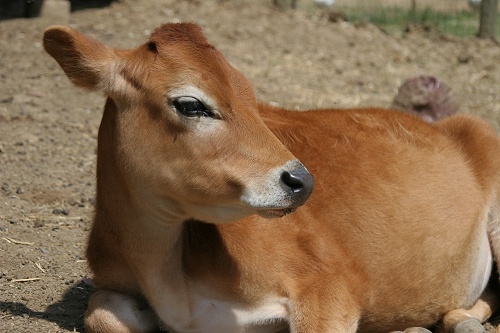I’m Abby, the sanctuary supervisor at Animal Place. Believe it our not, this is my first blog entry ever. I hope to give you insight into what happens at the sanctuary. Please enjoy! I’m looking forward to sharing with you different aspects of working with the animals at the sanctuary.
--------------------------------------------------------------------
It’s noon and I notice Nick, the steer, lazily chewing his cud in stall 3. As I pass, I glance over and smile at his comfortable spot in a large bed of straw. I’m off to run errands and when I return a couple hours later, Nick’s still in stall 3, still chewing his cud. Everything seems fine except for one thing; he’s not with Howie and Sadie, the other cattle. The cattle are always together, grazing the hillside or napping in the fields. It seems minor, but the separation could be the first indication of a problem.
It was only a few weeks ago that Nick battled pneumonia. Nick missed out on immunity-building colostrum from his mom. As a male dairy calf, he was considered useless by the farmer and, at a day of age, sent to auction. We rescued him after animal control confiscated him from an apartment complex (he was tied up with only hay for food). Knowing his history (pneumonia, a bad start early in life) and seeing him away from the other cattle got me a little concerned.
His temperature is pretty normal and he is breathing okay. I ask animal care staff how Nick has been acting. They noted he hadn’t moved from his spot. Our plan is to monitor his appetite, attitude, and temp the next couple days for changes and give the vet a call if things worsen.
Working at a sanctuary with the animals everyday gives me otherwise unseen insight into individual personalities and behaviors. In just the same way I know my cat Miles waits by the door to bolt when it’s opened, I know Etta, the sheep, loves to have her back scratched but hates her head touched. I know Peggy Sue, the pig, likes to eat breakfast in stall 5 with the cushy rubber stall pads instead of adjacent stalls 3 and 7 that have cement. Mindy, the turkey likes to wait in the doorway every morning for us to put her ramp in place so she doesn’t have to hop out and land on her arthritic legs.
Knowing Nick and how much he loves to track right behind the older cattle threw up a yellow flag that something might be off. The sanctuary animal care staff spend hours feeding and cleaning each day, but it’s not just a mechanical process. We watch the animals and notice when a hen seems a little off, if a goat took a little longer to make it to breakfast, or if pig seems to be lying down or standing up more. These observations are an integral part of my work (and all animal care staff) at the sanctuary. It can mean the difference between life and death for an animal.







2 comments:
Thanks for posting and reminding us that farmed animals are every bit as individual as our companion animals, and deserving of just as much care and respect. I hope little Nick is feeling better!
I agree with you Abby... any further coment email me please hmidence@purdue.edu
Post a Comment